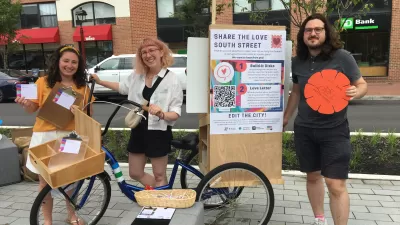Planners, like any other professionals, live in a kind of bubble. Those charged with dealing with the public run the risk of expecting too much from residents as they design community engagement activities. Here are some of the most common mistakes.

It's great to focus on the positive and celebrate the best case studies, but sometimes it's useful to learn from our mistakes. Despite our efforts to find the best examples, as we combed through hundreds of community engagement case studies to create this guidebook, we also encountered many clunkers.
Of course "clunker" is subjective and each project has different goals and objectives. For the purposes of this post, we only considered projects that did not meet their own stated projects goals by a significant margin. This typically translated to one of the following: too few participants, too narrow a demographic participating, or widespread discounting of the validity of the input gathered by the community engagement process.
After evaluating many case studies and interviewing the agencies involved, patterns started to emerge about lessons learned. It quickly became clear that the subtitle of this article could be "Great Expectations." Here are three of the most common mistakes that hampered outreach processes.
1. Expecting too much time
There seems to be a strong tendency to over-estimate the level of time that people are willing to spend participating in community engagement activities. Dedicated and enthusiastic planning professionals sometimes forget that most people don't get as excited about planning topics as we do. Others are well aware of short attention spans and talk about "scope creep," with community engagement exercises starting out lean and slowing building to something unwieldy before it finally goes out the door.
Keeping it short is not easy, and it's a trade-off. With less time per person, you'll be limited about how much detail you can get into. On the other hand, if it's too long you'll be limiting participation to only those who are most motivated—oftentimes motivated by negative feelings about the project. The breaking point seems to be about five minutes. Whether it's at a public event or online, asking visitors or passers-by for five minutes of their time seems to be a sweet spot that allows you to collect a fair amount of input from the largest number of participants. If your "call to action" captures their attention, most people will be willing to give you five minutes. Asking for less time does not seem to make a significant difference while asking for more time results in a sharp decline in participation rates. In our fast paced world, ten minutes can seem like an eternity, especially when you aren't particularly passionate about the issue.
2. Expecting too much empathy
Agencies conducting public participation for their planning projects have mandates, regulations, and specific objectives that they are striving to meet. Unfortunately, the public do not care about them like you do. Many of the projects we looked at focused too directly on agency objectives and missed many of the public's top of mind issues. The omission of key public priorities or undue focus on agency priorities can either infuriate people or simply drive them away.
It can be challenging but community engagement can simultaneously resonate with the agency goals and the public's priorities if you know what they are. Understanding and defining both the community’s priorities and the agencies early on the in process seems to be a critical success factor. While agency priorities are often well-established, community priorities are more elusive. Planners knowledge of community priorities can be heavily based on interactions with the small subset of people who typically show up at council meetings and public workshops. This, we can agree, is hardly a representative sample. Furthermore, the language that people use to describe the issues is also critical when designing your invitations to participate and content for your surveys or other community engagement activities. Some of the best case studies started with an open-ended survey, allowing people to identify issues and priorities early on before alternatives and options had been defined. These early inputs can help to shape the content for subsequent surveys or activities to ensure that the outreach resonates with the community. Many agency goals can then be connected to community priorities but some gaps are to be expected. These gaps can often be accommodated creatively as long as there is enough lead time work with both sets of priorities.
3. Expecting too much planning knowledge
The more you learn about a topic, the harder it is to remember what it was like to be a novice. To some extent we are all living in a "planning bubble," with our own lingo, acronyms, and a rather sophisticated understanding about cause and effect relationships of our complex built environment. Many of the case studies we examined were criticized for asking questions that the community did not fully understand. The result can be either less people being willing to participate or the community input being challenged as not informed or credible.
Language is relatively easy to change as long as you have editors that can translate the jargon into something more publicly accessible. This translation task works well in the early phases of community engagement when the input being collected is about priorities and issues. People find it relatively easy and comfortable to talk about what’s important to them or what concerns them about a topic or area.
Where even some of the most thoughtfully prepared projects had difficulty was at the options or alternatives phase of outreach. Asking people to nominate or choose among a set of possible solutions is far more difficult. The reason is that solutions require people to understand the cause and effect of the actions being considered. While some will have no trouble with this, it can be a big stretch for others.
The best case studies provided clear information about both the pros and cons of various options. Great caution must be taken to accommodate a wide range of stakeholders, including those who are very knowledgeable. By allowing a self serve learning experience participants needing additional information will find it when they need it. Providing this kind of unbiased and balanced information about the options can generate genuine community support as well as decision-maker confidence.
Learn more about lessons from community engagement missteps by following the Fiasco Files.

Coming Soon to Ohio: The Largest Agrivoltaic Farm in the US
The ambitious 6,000-acre project will combine an 800-watt solar farm with crop and livestock production.

Pennsylvania Mall Conversion Bill Passes House
If passed, the bill would promote the adaptive reuse of defunct commercial buildings.

U.S. Supreme Court: California's Impact Fees May Violate Takings Clause
A California property owner took El Dorado County to state court after paying a traffic impact fee he felt was exorbitant. He lost in trial court, appellate court, and the California Supreme Court denied review. Then the U.S. Supreme Court acted.

Colorado Bill Would Tie Transportation Funding to TOD
The proposed law would require cities to meet certain housing targets near transit or risk losing access to a key state highway fund.

Dallas Surburb Bans New Airbnbs
Plano’s city council banned all new permits for short-term rentals as concerns about their impacts on housing costs grow.

Divvy Introduces E-Bike Charging Docks
New, circular docks let e-bikes charge at stations, eliminating the need for frequent battery swaps.
City of Costa Mesa
Licking County
Barrett Planning Group LLC
HUD's Office of Policy Development and Research
Mpact Transit + Community
HUD's Office of Policy Development and Research
Tufts University, Department of Urban and Environmental Policy & Planning
City of Universal City TX
ULI Northwest Arkansas
Write for Planetizen
Urban Design for Planners 1: Software Tools
This six-course series explores essential urban design concepts using open source software and equips planners with the tools they need to participate fully in the urban design process.
Planning for Universal Design
Learn the tools for implementing Universal Design in planning regulations.



























